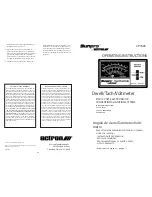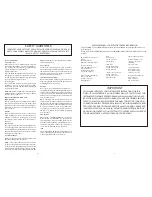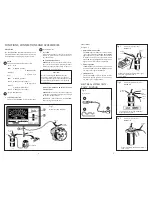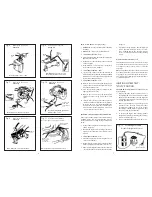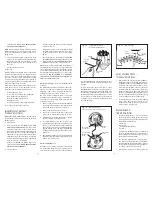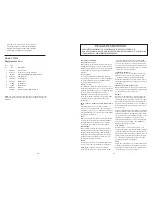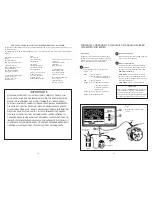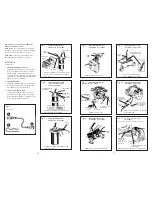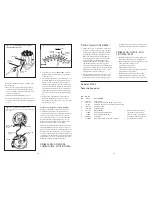
3
SAFETY GUIDELINES
TO PREVENT ACCIDENTS THAT COULD RESULT IN SERIOUS INJURY AND/OR DAM-
AGE TO YOUR VEHICLE OR TEST EQUIPMENT, CAREFULLY FOLLOW THESE SAFETY
RULES AND TEST PROCEDURES
SAFETY EQUIPMENT
Fire Extinguisher
Never work on your car without having a suitable
fi re extinguisher handy. A 5-lb or larger CO
2
or
dry chemical unit specifi ed for gasoline/chemi-
cal/electrical fi res is recommended.
Fireproof Container
Rags and fl ammable liquids should be stored only
in fi reproof, closed metal containers. A gasoline-
soaked rag should be allowed to dry thoroughly
outdoors before being discarded.
Safety Goggles
We recommend wearing safety goggles when
working on your car, to protect your eyes from
battery acid, gasoline, and dust and dirt fl ying off
moving engine parts.
NOTE: Never look directly into the carburetor throat
while the engine is cranking or running, as sudden
backfi re can cause burns.
LOOSE CLOTHING AND LONG HAIR
(MOVING PARTS)
Be very careful not to get your hands, hair or clothes
near any moving parts such as fan blades, belts
and pulleys or throttle and transmission linkages.
Never wear neckties or loose clothing when work-
ing on your car.
JEWELRY
Never wear wrist watches, rings or other jewelry
when working on your car. You’ll avoid the pos-
sibility of catching on moving parts or causing
an electrical short circuit which could shock or
burn you.
VENTILATION
The carbon monoxide in exhaust gas is highly toxic.
To avoid asphyxiation, always operate vehicle in a
well-ventilated area. If vehicle is in an enclosed area,
exhaust should be routed directly to the outside
via leakproof exhaust hose.
SETTING THE BRAKE
Make sure that your car is in Park or Neutral, and
that the parking brake is fi rmly set.
NOTE: Some vehicles have an automatic release
on the parking brake when the gear shift lever
is removed from the PARK position. This feature
must be disabled when it is necessary (for testing)
to have the parking brake engaged when in the
DRIVE position. Refer to your vehicle service manual
for more information.
HOT SURFACES
Avoid contact with hot surfaces such as exhaust
manifolds and pipes, muffl
ers (catalytic converters),
radiator and hoses. Never remove the radiator cap
while the engine is hot, as escaping coolant under
pressure may seriously burn you.
SMOKING AND OPEN FLAMES
Never smoke while working on your car. Gasoline
vapor is highly fl ammable, and the gas formed in
a charging battery is explosive.
BATTERY
Do not lay tools or equipment on the battery. Ac-
cidentally grounding the “HOT” battery terminal can
shock or burn you and damage wiring, the battery
or your tools and testers. Be careful of contact with
battery acid. It can burn holes in your clothing and
burn your skin or eyes.
When operating any test instrument from an
auxiliary battery, connect a jumper wire between
the negative terminal of the auxiliary battery and
ground on the vehicle under test. When working
in a garage or other enclosed area, auxiliary bat-
tery should be located at least 18 inches above
the fl oor to minimize the possibility of igniting
gasoline vapors
HIGH VOLTAGE
High voltage — 30,000 to 50,000 volts — is present
in the ignition coil, distributor cap, ignition wires
and spark plugs. When handling ignition wires
while the engine is running, use insulated pliers to
avoid a shock. While not lethal, a shock may cause
you to jerk involuntarily and hurt yourself.
JACK
The jack supplied with the vehicle should be used
only for changing wheels. Never crawl under car
or run engine while vehicle is on a jack.
2
VEHICLE MANUAL, SOURCES FOR SERVICE INFORMATION
The following is a list of publishers who have service manuals for your specifi c vehicle at
nominal cost.
Write to them for availability and prices, specifying the make, style, and model year of your
vehicle.
American Motors Corporation
Myriad
8835 General Drive
Plymouth Township, MI 48170
Chrysler Corporation
Dyment Distribution Service
Service Publication
20770 Westwood Drive
Strongsville, OH 44136
Ford Publications Department
Helm Incorporated
Post Offi
ce Box 07150
Detroit, MI 48207
Buick
Tuar Company
Post Offi
ce Box 354
Flint, MI 48501
Oldsmobile
Lansing Lithographers
Post Offi
ce Box 23188
Lansing, MI 48909
Cadillac, Chevrolet, Pontiac
Helm Incorporated
Post Offi
ce Box 07130
Detroit, MI 48207
OTHER SOURCES- Nonfactory
Domestic and Import Cars
Chilton Book Company
Chilton Way
Radnor, PA 19089
Cordura Publications
Mitchell Manuals, Inc.
Post Offi
ce Box 26260
San Diego, CA. 92126
Motor’s Auto Repair Manual
Hearst Company
250 W. 55th Street
New York, NY 10019
IMPORTANT
THIS MANUAL PRESENTS COMPLETE HOOKUP INSTRUCTIONS FOR THE
DWELL/TACH/VOLTMETER, IT ALSO DESCRIBES MANY OF THE TESTS THAT THIS
INSTRUMENT IS CAPABLE OF PERFORMING AS WELL AS WHEN THEY SHOULD
BE USED BASED ON VEHICLE PERFORMANCE, TUNE-UP OR TROUBLE ENCOUN-
TERED. CONSULT YOUR VEHICLE SERVICE MANUAL FOR SPECIFIC TUNE-UP IN-
FORMATION AND TEST PROCEDURES. ALWAYS FOLLOW THE MANUFACTURER’S
SPECIFICATIONS AND TEST PROCEDURES FOR ADJUSTING DWELL ANGLE AND
IDLE SPEED, ESPECIALLY ON VEHICLES WITH MODERN ELECTRONIC IGNITION
AND EMISSION CONTROLS. DO NOT ATTEMPT TO SERVICE A VEHICLE WITHOUT
THE MANUFACTURER’S INSTRUCTIONS AND SPECIFICATIONS.

